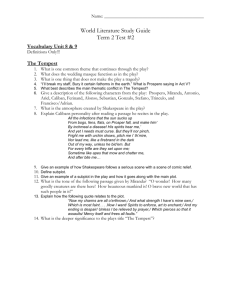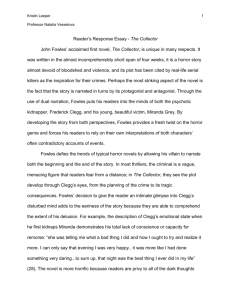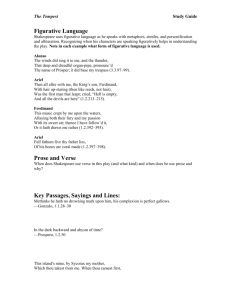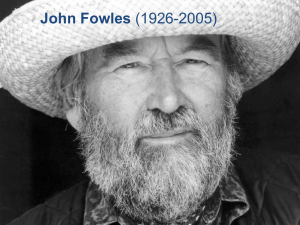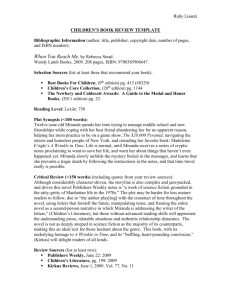Individualism in John Fowles' novel The Collector, as demonstrated
advertisement
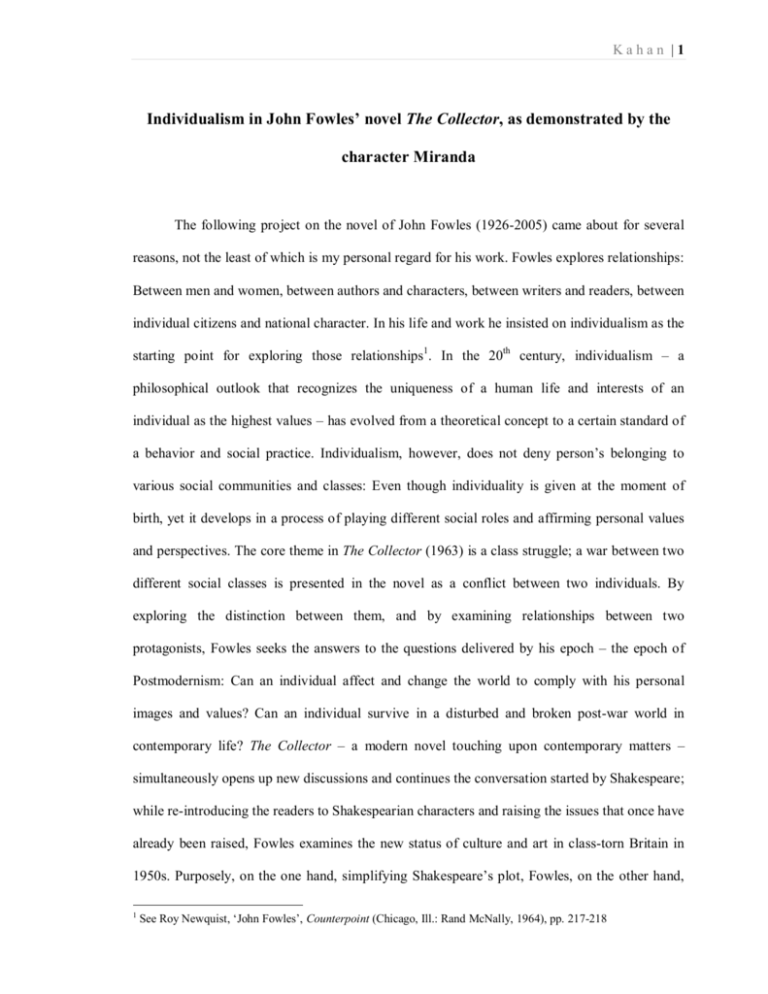
Kahan |1 Individualism in John Fowles’ novel The Collector, as demonstrated by the character Miranda The following project on the novel of John Fowles (1926-2005) came about for several reasons, not the least of which is my personal regard for his work. Fowles explores relationships: Between men and women, between authors and characters, between writers and readers, between individual citizens and national character. In his life and work he insisted on individualism as the starting point for exploring those relationships1. In the 20th century, individualism – a philosophical outlook that recognizes the uniqueness of a human life and interests of an individual as the highest values – has evolved from a theoretical concept to a certain standard of a behavior and social practice. Individualism, however, does not deny person’s belonging to various social communities and classes: Even though individuality is given at the moment of birth, yet it develops in a process of playing different social roles and affirming personal values and perspectives. The core theme in The Collector (1963) is a class struggle; a war between two different social classes is presented in the novel as a conflict between two individuals. By exploring the distinction between them, and by examining relationships between two protagonists, Fowles seeks the answers to the questions delivered by his epoch – the epoch of Postmodernism: Can an individual affect and change the world to comply with his personal images and values? Can an individual survive in a disturbed and broken post-war world in contemporary life? The Collector – a modern novel touching upon contemporary matters – simultaneously opens up new discussions and continues the conversation started by Shakespeare; while re-introducing the readers to Shakespearian characters and raising the issues that once have already been raised, Fowles examines the new status of culture and art in class-torn Britain in 1950s. Purposely, on the one hand, simplifying Shakespeare’s plot, Fowles, on the other hand, 1 See Roy Newquist, ‘John Fowles’, Counterpoint (Chicago, Ill.: Rand McNally, 1964), pp. 217-218 Kahan |2 complicates the characters, by focusing four images into two: Thus, Fowles’ Miranda’s character combines Shakespearean images of Miranda and Ariel, and Clegg’s character is an uneasy combination of Ferdinand and Caliban. Such a new interpretation of prototype images clearly illustrates Fowles’ perspective on new types of individuals in contemporary Britain – the products of mutated postmodern culture and society. The novel, so pessimistic and dark already on the first pages, suggests that modern British society is a society of struggling egotistic individuals; and this society – with the shifting social classes which inevitably leads to transformation of generally accepted assumptions of manners and standards of behavior – cannot, or, perhaps, does not deserve to be saved. My project undertakes to examine Fowles’ perspectives and illustrate them by taking a close look at the novel’s characters; and, specifically, to demonstrate the impossibility of individual survival as demonstrated by the character of Miranda. Throughout its long history, literature has always been the highest manifestation of aesthetics: It was literature that has created ideals, aroused urgent themes, explored social and philosophical conflicts, and the relationships between men – with the purpose to cognize and to ameliorate life. The 1950s in England, however, brought disappointment and crises. Devastated and exhausted after the Second World War, Englishmen found themselves on the subtle verge of self-destruction. In this situation – when the events that occurred in reality were stronger than those in literature – people questioned the high ideals and ethics that literature had to offer before. Just as British society was disappointed in the values of the Renaissance and Enlightenment epochs – in their belief in progress, in the triumph of the intellect, and in the unboundedness of a human potential, it was “tired” of the cleavage and revolutionary character of avant-garde2. Overall, Postmodernism in Britain can be characterized as an entropic culture of 2 Another approach to postmodern phenomenon was suggested by Fredric Jameson in his book Postmodernism, or The Cultural Logistic of Late Capitalism. Jameson insists that it is essential to grasp postmodernism not as a style, but as a dominant cultural form indicative of late capitalism; for the two approaches (historical and stylistic) generate two different ways of conceptualizing the phenomenon of postmodernism as a whole: On the one hand, moral judgments, and, on the other, a genuinely dialectical attempt to think the present of time in History. Postmodernism is marked by the repudiation of ideological (social class, Leninism, social democracy, welfare state) Kahan |3 past forms and epochs, hallmarked with eschatological feelings, aesthetical mutations, diffusions of high styles, and eclectic merging of artistic languages. Postmodernism tends to include all the experiences accumulated by world culture in the sphere of modern art, by means of its constant quoting. John Fowles – one of the most brilliant postmodern writers – inspired and guided by the pattern of classical literature, often bases his literary plots on myths and known stories, playing with the traditional texts by subjecting them to different types of metamorphoses and transformations. This broad employment of literary and mythological allusions helps Fowles to represent his own philosophic and aesthetic principles, as well as create his characters; which is a distinctive feature of the author’s style. By bringing together literary works from different cultural epochs, various ideologies and world outlooks in his novels, Fowles reveals a complexity and a discrepancy of his characters; and by doing that he uncovers the catholicity and extraordinariness of the individual’s personality: combinations of the high and low, pure and impure in a man’s soul. The Collector had a few sources3. Fowles once saw a performance of Bartok’s Bluebeard’s Castle and was deeply impressed by the musical symbolical interpretation of the famous literary plot – a man imprisoning women underground – that uncovered a conflict of a true expressionistic drama. He also read in the newspapers about a London boy who kidnapped a girl and kept her in an air-raid shelter for three months until she found a way to escape. Finally, The Tempest – “a great Renaissance tragedy of lost illusions4” – Fowles’ favorite Shakespeare play that makes direct references to contemporary matters. As this essay states, The Collector is a new original interpretation of the play’s philosophic, ethic and aesthetic conflicts. Fowles transfers the images of Shakespeare’s characters with a certain intention, and although he and aesthetic (painting, philosophy, forms of representation in the novel, films, poetry) movements, and arrival of a “whole new type” of society. Every position on postmodernism in culture is political stance on the nature of multinational capitalism. All new postmodern cultural forms are indicative of late capitalism. 3 See Peter Conradi, “John Fowles” (Methuen, London and New York, 1982) pp. 33-34 and Roy Newquist, ‘John Fowles’, Counterpoint (Chicago, Ill.: Rand McNally, 1964), p. 220 4 “Shakespeare’s Late Plays,” edit. By Richard C. Tobias and Paul G. Zolbroc (Ohio University Press: Athens, 1974) p. 16 Kahan |4 deliberately reduces the number of heroes and changes them, providing them with new qualities and conducts, I will draw attention to the place that Shakespeare takes in postmodern literature and specifically in Fowles’ literary works. In his critical essay, Douglas Lanier talks of Shakespeare as a “high-cultural foil” against which one can “establish themselves as ‘popular,’ ‘democratic,’ ‘modern’ alternatives.”5 Indeed, Shakespeare’s plays have been rewritten, appropriated, adapted and interpreted since Shakespeare himself appeared in literature and on the stage6; writers, actors, producers and directors have always been inspired by Shakespeare. One of the reasons for such extraordinary popularity and admiration lies in the fact that Shakespeare is aesthetically refined, timeless, complex and intellectually challenging; Shakespeare symbolizes high art in general. “Shakespeare” often becomes a standardized plot, a stereotypical character, and especially a moral or ethical choice. Even in post-modernity, the age in which distinctions between high and low have supposedly collapsed, Shakespeare remains as an “important symbolic site of struggle between stratified cultural institutions.”7 His characters become certain cultural types, instantly recognizable when their names are involved. When we first read Miranda’s name in The Collector, we at once start looking at her literary image through a prism of Shakespeare’s heroine’s image, comparing and contrasting them. It is apparent that the modern versions of the figures often differ significantly from their Shakespearean “originals;” but the very changes marked by these appropriations tell a revealing story about modern culture and modern life. The idyllic, somewhat improbable plot of The Tempest touches themes which Fowles finds still contemporary and urgent in a context of the modern epoch – specifically, inescapable limitations of the human situation, the role of art and imagination in coping with that situation, and the limits of art.8 The main character – Prospero, the Duke of Milan, slandered and usurped 5 Douglas Lanier, “Shakespeare and Modern Popular Culture” (Oxford University Press, 2002) p. 44 Some of the examples are The English Traveller (1633) by Thomas Heywood; Enchanted Isle (1848) by Robert and William Brough; A Tempest(1969) by Aime Cesaire 7 Douglas Lanier, “Shakespeare and Modern Popular Culture” (Oxford University Press, 2002) p. 49 8 This research examines the pointed themes as demonstrated by the character Miranda, as they are associated with the problem of individualism and individuality in the Fowles’ novel 6 Kahan |5 by his brother Antonio, escapes to a desert island with his daughter Miranda, where for twelve years he waits for the day of reckoning. Knowing mysteries and possessing magic powers, Prospero subdues the spirit Ariel, and the island’s rightful owner, the monster Caliban, the son of the witch Sycorax. Using his witchcraft, Prospero creates the tempest and entices his enemies to the island. He passes fair justice and restores his good name by uniting the hearts of Miranda and noble Ferdinand, the son of Alonso, the King of Naples. In The Tempest Prospero creates the ideal commonwealth – life, however, is more stubborn than that, and part of the greatness of the play is that it forces the reader to recognize that. The Tempest is a play of an exceptional imaginative power; “it helps us to face with something that is neither wishfulness nor despair – with something that is both resigned and positively affirming – the intractabilities and the limitations of our lives.”9 Like Shakespeare, Fowles explores these limitations, and demonstrates them by the individuals in The Collector, “solitaries and visionaries who operate outside the mainstream and who seek to make their own peace.”10 As The Tempest is the story of “art and science at a crossroads, of the aesthetic and the instrumental, the psychological, the biological, the creative imperatives and the death drive,”11 all “bound up” to use Ferdinand’s wondering phrase, “as in a dream,” (Shakespeare, 24) Fowles brings up similar subjects in The Collector – the question of what constitutes real teaching and of the right use of violence; the question of freedom; the value of art; the effects of money on human beings, and more. The novel The Collector is a story about an ordinary city hall clerk Frederick Clegg (or Ferdinand, as the character calls himself, or later Caliban, as the female protagonist calls him), who is obsessed with the twenty year-old art student Miranda Grey. Frederick wins a large sum of money in a football pool, after which he buys a countryside house, kidnaps Miranda and keeps her in the cellar of the house, where she dies not long after. There are two viewpoints presented in the novel: First, the narrative is carried by Clegg, and we look at the events through his eyes; 9 “Shakespeare’s Late Plays,” edit. By Richard C. Tobias and Paul G. Zolbroc (Ohio University Press: Athens, 1974) p. 30 10 Thomas C. Foster, “Understanding John Fowles” (University of South Carolina Press, 1994), p. 8 11 Christopher Pye, “The Vanishing: Shakespeare and the Subject, and Early Modern Culture” (Duke University Press: Durham & London, 2000), p. 7-8 Kahan |6 and second, Miranda’s journal, which tells us the same story but from her perspective. The last part brings us back to Clegg’s narrative, which carries us through the end of the story. The most important part of The Collector for this essay is Miranda’s journal because it gives us a good idea of her personality and outlooks.12 Fowles gives a deep socio-psychological analysis of the spiritual impulses and deeds of Miranda – throughout the novel she reasons, argues with her abductor and introspects. Miranda Grey appears as the absolute opposite of Clegg; she represents everything that Clegg lacks – beauty, talent, creativity, artistic individuality; her image is complicated and many-faceted; she is well-off financially, popular and confident. Perhaps the biggest difference between her and Clegg, aside from gender, is class distinction: “I hate the uneducated and the ignorant. I hate the pompous and the phony. I hate the jealous and the resentful. I hate the crabbed and the mean and the petty. I hate all ordinary dull little people who aren’t ashamed of being dull and little. I hate what G.P. calls the New People, the new-class people with their cars and their money and their tellies and their stupid vulgarities and their stupid crawling imitation of the bourgeoisie.” (Fowles, 221) The class war between the two gives consideration to a few questions. First, it points to a breakdown of the ethical, spiritual, and cultural systems in the society they portray. Fowles makes this point specifically when he has Miranda deride the “New People” – the materialistic, upwardly mobile members of the working and lower classes who are destroying the culture and landscape, who are happy with their cars and their televisions, and who are taking over from the formerly stable privileged classes. Miranda is the daughter of a doctor, she grew up in a wealthy family and her future was secured. However, she is different from most people she is surrounded by: She understands the responsibility of her social class to be an intellectual core of the country, to preserve it from a cultural and aesthetical collapse. Miranda considers intelligence as the essence of her class, and she disregards the money: “I used to think D and M’s class the worst. 12 This essay does not state that Clegg is void of individuality; however, in the boundaries of this research I will examine the problem of individualism as it is developed on Miranda’s character Kahan |7 All golf and gin and bridge and cars and the right accent and the right money and having been to the right school and hating the arts (the theatre being a pantomime at Christmas and Hay Fever by the Town Rep – Picasso and Bartok dirty words unless you wanted to get a laugh).” (Fowles, 172) However, such people – rich idlers, who spend their money uselessly – are not a true danger for society; the true socially dangerous people are those like Clegg, as she adds: “Well, that is foul. But Caliban’s England is fouler. It makes me sick, the blindness, deadness, out-of-dateness, stodginess and, yes, sheer jealous malice of the great bulk of England.” (Fowles, 172) Such people, erroneously assuming that money is a staff of power, turn into monsters when stacks of cash are in their possession: Clegg, for instance, kidnaps Miranda, not even realizing that he is committing a crime. This brings us to the second question, aroused by the theme of a class struggle – a question of England. The question “is not, as in E. M. Forster’s Howards End, who shall inherit England – that was a question for an earlier generation. Instead – what is England that anyone would want to inherit it or to live there?”13 Fowles shows what he dislikes about England, but he doesn’t show England that he does admire. The story closes out positive possibilities and wholesome alternatives. In general, the author is not terribly enthusiastic about any of the social classes in England, although he believes in the possibility of individual redemption14. The Collector, then, sets up an issue whose resolution must be delayed for later consideration. Fowles’ Miranda thinks about the gigantic space between her and Clegg-Caliban. She thinks about artistic explorations and inspirations, the important role of art – painting, music, literature – in the process of a man’s spiritual growth. Her world is colorful and tempestuous, and his – doleful and grey. This is the reason why Fowles puts Shakespeare’s The Tempest a certain symbolic detail, in the novel’s storyline. Miranda is re-reading The Tempest in her imprisonment: “Reading The Tempest again all the afternoon. Not the same at all, now what’s happened has happened. The pity Shakespeare feels for his Caliban, I feel (beneath the hate and 13 14 Thomas C. Foster, “Understanding John Fowles” (University of South Carolina Press, 1994), p. 35 Throughout the research I will explore the reason why Miranda’s character cannot become a “hero” on the epoch Kahan |8 disgust) for my Caliban. Half-creatures. ‘Not honour’d with a human shape.’ ‘Caliban my slave, who never yields us kind answer.’ ‘Whom stripes may move, not kindness.’ Prospero’s contempt for him. His knowing that being kind is useless.” (Fowles, 263) It is important to notice, that Shakespeare’s works generally speaking are not about art, but of art; however, the theme of art undoubtedly was of his big interest. Art is something people create because their lives are imperfect, and one of the functions of art is to make life as perfect as possible, and to imaginatively explore what perfection would really be like; thus “Shakespeare, in celebrating man’s art, is by implication also celebrating the imperfection of man, his morality and the double nature of his conciseness, without all of which art would not exist.”15 In The Tempest the embodiment of art was the spirit Ariel; his art was an art of music, which had an important role in the play, and once in a while substituted his magic.16 In The Collector Ariel’s role of a spiritual artist belongs to Miranda. However, Miranda, unlike Ariel, is not a pure spirit, just like Clegg is not a pure “nature.” Fowls, like Shakespeare, shows that a man cannot reach perfection, cannot become pure spirit nor pure matter, but he is caught in an uneasy tension between the two – and this is unique, and implicitly tragic: “Man is not capable of either kind of perfection [Caliban/Ariel], and Shakespeare pointed out this dilemma; any attempt to reach such perfection involves a misconception of the nature of human life and an abdication of moral responsibility.”17 The compression of two Shakespearean characters into two Fowles’ figures also demonstrates how Fowles’ perceives the new types of individual in contemporary England: As there is a class-struggle within society, there is also a struggle within each individual. A man cannot find his place in society and in life, because he cannot yet get to know and recognize his own self. Fowles focuses his attention on Miranda’s self-consciousness, 15 “Shakespeare’s Late Plays,” edit. By Richard C. Tobias and Paul G. Zolbroc (Ohio University Press: Athens, 1974) p. 164 16 We can recall the episodes when Ariel sings to Ferdinand, to sleeping Ganzalo, and to Prospero; Stephano sings; and even Caliban sings 17 “Shakespeare’s Late Plays,” edit. By Richard C. Tobias and Paul G. Zolbroc (Ohio University Press: Athens, 1974) p. 162 Kahan |9 and her constant attempts to learn who she really is, while her spiritual source confronts the material and egotistic trait of her subjectivity. John Fowles shows a process of the internal development of Miranda’s personality by displaying her image in dynamics and evolution – she goes through self-examination, selfanalysis and a revaluation of values. Her spiritual life in imprisonment is a constant struggle between dignity, fear, impudent challenges, thirst for freedom and compromise. Miranda perceives a surrounding world, discovers and acquires herself through art – the art of literature, painting and sculpture: She learns about “important things by people who really feel about life.” (Fowles, p. 156) She is a very spiritual character in the novel, able to feel, sense and truly introspect. Even in imprisonment she manages to live in a world of bright memories, visions and fantasies: “No past, no future. All intense deep that-time-only. A feeling that everything must end, the music, ourselves, the moon, everything. That if you get to the heart of things you find sadness for ever and ever, everywhere; but a beautiful silver sadness, like a Christ face…Like lying on one’s back as we did in Spain when we slept out looking up between the fig-branches into the star-corridors, the great seas and oceans of stars. Knowing what it was to be in a universe.” (Fowles, 202) She is in love with life and art, she is full of a desire to live and survive at any cost: “I love honesty and freedom and giving. I love making, I love doing. I love being to the full, I love everything which is not sitting and watching and copying and dead at heart…I want to paint… with… simplicity and light… I want to paint sunlight on children’s faces, or flowers in a hedge or a street after April rain. The essences. Not the things themselves. Swimmings of light on the smallest things.” (Fowles, 221, 138) Fowles endows his Miranda with an ability to see and to subtly feel the uniqueness and harmony of natural beauty: “…Beautiful outdoor air. That was good, so good I can’t describe it. So living, so full of plant smells and country smells and the thousand mysterious wet smells of the night…The beautiful clean sun on the blood-red stems…Moods of light recalled… Ochre walls burnt white in the sunlight. The walls of Avila. Cordoba courtyards. I don’t try to reproduce the place, but the light of the place. K a h a n | 10 Fiat lux.” (Fowles, 145, 212, 269) Miranda’s internal light gives her strength to save her humanity, her ability to think, sympathize, and even a desire to share this light with Clegg, or at least to try to acquit him: “I feel the sadness of his life, too, terribly… The great dull hopeless weight of it. Like those Henry Moore drawings of the people in the Tubes during the blitz. People who would never see, feel, dance, draw, cry at music, feel the world, the west wind. Never be in any real sense.” (Fowles, p. 200) Miranda’s spiritual world is fully dependent on her sense of art: Art is in the core of her life, she sees and understands everything in the light of art – people, nature, society and politics. She lives by art, it is the meaning of her life and art for her is an absolute beauty and fascination, while “everything to do with art embarrasses him [Clegg]… He knows great art is great, but ‘great’ means locked away in museums and spoken about when you want to show off. Living art, modern art shocks him. You can’t talk about it with him because the word ‘art’ starts off a whole series of shocked, guilty ideas in him.” (Fowles, p. 246) This side of Fowles’ Miranda is very similar to her Shakespearean prototype; and the spiritual and intellectual barriers that separate Miranda Grey and Clegg are like those that separated Miranda and Caliban in The Tempest. Both Miranda Grey and Miranda were educated by art; however such “careful” education is obviously incomplete – it is very limited, not life-oriented and naturally leads to certain limitations of views and perspectives: Shakespearean Miranda mistakes a group of scoundrels, usurpers, drunks, fools, and would be assassins for the cream of mankind – “brave new world,” (Shakespeare, 72) and Miranda Grey loses her only chance to escape when she cannot hit Clegg with an ax: “I hate myself. I nearly became a murderess tonight. I shall never be the same again… Then he began to straighten up (all this happened in a flash, really) and I did hit him. But he was turning and I didn’t hit straight. Or hard enough. I mean, I lashed out in a panic at the last moment. He fell sideways, but I knew he wasn’t knocked out, he still kept hold of me, I suddenly felt I had to kill him or he would kill me. I hit him again, but he had his arm up, at the same time he kicked out and knocked me off my feet.” (Fowles 243-244) However, K a h a n | 11 Shakespearean Miranda’s fortune brought her together with Ferdinand, while Miranda Grey came to be with Caliban; and if Fowles provides his Miranda with the features of Miranda of the 17th century18, and he doesn’t show us modern Ferdinand to compare, he clearly points out how Caliban’s image has changed. His nature stays the same: He is “earthy”, “native;” 19 but the reasons of why Caliban’s nature (or personality) is so, are very different: Shakespearean Caliban is not completely a human being; he is more like a beast, a savage; Fowles’ Clegg-Caliban is a human, civilized and not mindless. Clegg chooses to be like Caliban, and this is why he is so dangerous. In the episode when Caliban is attempting to rape Miranda in The Tempest, he is merely following the imperatives of his own nature;20 in Clegg’s desire to possess Miranda there is nothing natural. The 17th century Caliban is amoral; the 20th century Clegg is immoral. It is obvious that John Fowles saw these changes as the most tragic; and this problem as the most urgent. As Caliban leads the commentator to discuss Shakespeare’s interest in the world of new discovery and in the impact of civilization on the native, Clegg’s figure is of Fowles’ interest in terms of the struggle between intelligence and money: “…But that was my mistake before, aiming too high, I ought to have seen that I could never get what I wanted from someone like Miranda, with all her la-di-da ideas and clever tricks. I ought to have got someone who would respect me more. Someone ordinary.” (Fowles, 304) Fowles puts forth a question if there are more of those like Miranda, or those like Caliban; but leaves the question unanswered. 18 There is a difference, though, in the impact of an isolation on both heroines: Miranda’s isolation leads to her exceptional spirituality; and Miranda Grey’s isolation leads to her “alienation” (see Thomas C. Foster, “Understanding John Fowles” (University of South Carolina Press, 1994), p. 40) 19 To underline this “earthiness” Fowles often mentions his hobby (a butterflies collectioner); Clegg lives isolated in the countryside; the events take place in fall, and we constantly read about the weather (rain, wind, storm, thunder and lightning, heavy air, etc.) 20 An interesting observation is given by Robert Longbaum: “Caliban is natural in that he is earthy and earthbound, low, material… But Miranda is also natural, and the two are contrasted throughout. Both were brought out in a state of nature; and if Miranda never saw a man other than her father, Caliban never saw a woman other than his mother. Caliban is natural in the sense that nature is rudimentary and mindless; he cannot be educated. Miranda is natural in the sense that we take the Golden Age or The Garden of Eden to be our natural condition.” (Robert Longbaum, “The Tempest and Tragicomic Vision. The Modern Spirit” (NY: Oxford University Press, 1970), pp. 189-190) I find it necessary to specify that I cannot completely agree with this observation, as I consider Miranda as a civilized human being, brought up by her royal educated father K a h a n | 12 Miranda Grey’s personality has not completely formed yet. She looks at the world through the eyes of her friend, a forty year old artist George Paston (who she calls G. P.) His outlook is her outlook, his thoughts are her thoughts. Miranda is constantly reading books, and each book heroine reminds her of herself: Thus, she associates herself with Anne Frank, Emma, or Miranda. However, Fowles uses Miranda’s diary as a psycholinguistic model of her growth and introspection. She always struggles with her literary chores; though she is a self-conscious writer. Because many of her paragraphs are one or two sentences, and she seldom makes much transition between thoughts, it is apparent that her task is difficult. However, as Katherine Tarbox points out, “Miranda’s writing is more creative than her drowning because it is free from outside influences and is unbound by traditions, conventions, and expectations; it seems so spring fresh, new, from nothing.”21 A person who tries to find him- or herself in the world is an ordinary person of a postmodern epoch. Fowles insists that such search leads to spirituality, and is a feature of an educated and intellectual man. Miranda doesn’t know who she is, yet she knows exactly what she likes and doesn’t like: She dislikes Sillitoe’s novel chiefly because of its hero’s antipathy to societal norms and, especially, to art and culture. A large part of her growth as an individual stems from her battle with language and from asking questions such as “Who am I?” An opportunity to write, brushes and canvas, and books are Miranda’s thread of Ariadne – the only one possible way to communicate with the outer world that brings her hope and a desire to live. Just like Fowles’ Miranda, Shakespeare’s Prospero could hardly become a powerful master of the island, pass justice and restore a good name without his books: “Knowing I loved my books, he furnish'd me / From mine own library with volumes that / I prize above my dukedom.” (Shakespeare, 12) For Fowles’ heroine, books occur to be a consolation, a source of strength and an interlocutor. 21 Katherine Tarbox, “The Art of John Fowles” (The University of Georgia Press: Athens & London, 1988), p. 47 K a h a n | 13 There is another question that remains unanswered – Fowles’ choice of characters, namely, the absence of Prospero. In The Tempest Prospero is a certain model of the artist, and his manipulation of nature on his island can be seen as a model for the role of the artist in a human society: To impose his imaginative ideals on recalcitrant nature to whatever extent possible, but to recognize the limitations of the human spirit in overcoming nature; to live as much as possible with Ariel while remembering that man is partly Caliban. In this sense Miranda Grey’s image is close to Prospero’s one: She is trying to change Clegg; pedagogy is an important notion in this book, with Miranda trying to teach Clegg about art and manners. However, Miranda fails as an educator, because she is a poor-teacher and her knowledge is not enough. Another Prospero’s function in The Tempest is his managing of the happening events – after all, the “happy ending” depends on how Prospero handles the situation. It was Prospero who arranged Miranda and Ferdinand’s engagement, and that was him who protected Miranda from Caliban; there can be no Prospero in Fowles’ novel because the writer doesn’t see such a character in the contemporary world. Finally, Fowles obviously considers that Caliban became the Prospero on the 20th century: Caliban, not Prospero is now holding “the staff and book,” and wears “the magic robe of art.”22 Prospero’s absence, though, is another Fowles’ characterization of the contemporary English reality. His complete understanding of the present cultural and historical crises – namely the loss of the Empire, mixed with the sense of destruction throughout Europe and particularly in Britain, a feeling of being displaced by America as a world power – clearly demonstrates Fowles’ perspective that there is no viable Prospero left in this historical moment; as Fredric Jameson posits it, “this whole global, yet American, postmodern culture is the internal and superstructural expression of a whole new wave of American military and economic domination 22 Marjorie Garber, “Shakespeare and Modern Culture” (Pantheon Books: NY, 2008), p. 32 K a h a n | 14 throughout the world: In this sense... the underside of culture is blood, torture, death, and terror.”23 John Fowles gives the reader of The Collector darkness, pain, despair, and death; the reader of The Collector is required to hope that Miranda will escape, though he knows almost from the beginning that she will not. There is hope that somewhere Fowles will reveal some justification, as in classical tragedy, for the torments to which he subjects the reader. But no amount of critical examination will reveal any brightness or hope beneath the bleak facade. The Collector is a sad, black and wrathful diatribe against the abuses of freedom, and cultural, ethical and spiritual breakdowns in society. The theme of “otherness” sounds very clearly in The Collector, as well as the conflict between the Few and the Many. In his novel Fowls insists that it is as much an admonition of the future, as it is a depiction of the present. 23 Fredric Jameson. Postmodernism, or The Cultural Logistic of Late Capitalism (Duke University press, 2003), p. 5 K a h a n | 15 Bibliography: 1. John Fowles. The Collector. Boston, New York, London: Back Bay Books, 1997 2. William Shakespeare. The Tempest: An authoritative text sources and contexts criticism; rewritings and appropriations. New York, London: W. W. Norton and Company, 2004 3. Douglas Lanier. Shakespeare and Modern Popular Culture. Oxford University Press, 2002 4. Shakespeare’s Late Plays. Edited by Richard C. Tobias and Paul G. Zoldbrod. Ohio University Press: Athens, 1974 5. Christopher Pye. The Vanishing: Shakespeare, the Subject, and Early Modern Culture. Duke University Press: Durham and London, 2000 6. Marjorie Garber. Shakespeare and Modern Culture. Pantheon Books, NY, 2008 7. Thomas C. Foster. Understanding John Fowles. University of South Carolina Press, 1994 8. Barry N. Olshen. John Fowles. Frederick Ungar Publishing Co.: NY, 1978 9. Katherine Tarbox. The Art of John Fowles. The University of Georgia Press: Athens and London, 1988 10. Peter Conradi. John Fowles. Methuen: London and New York, 1982 11. Robert Longbaum. The Tempest and Tragicomic Vision. The Modern Spirit. Oxford University Press: NY, 1970 12. Roy Newquist, ‘John Fowles’, Counterpoint. Rand McNally: Chicago, Ill., 1964, pp. 217-225 13. Fredric Jameson. Postmodernism, or The Cultural Logistic of Late Capitalism. Duke University press, 2003
